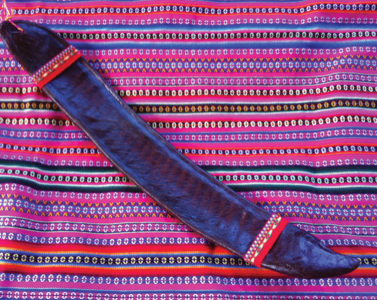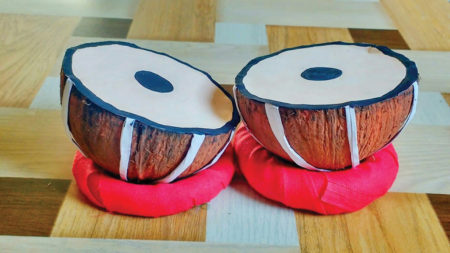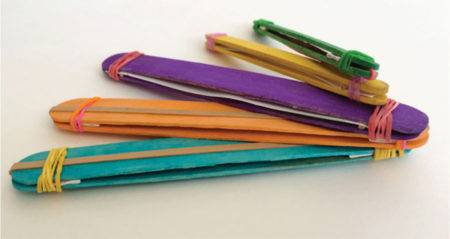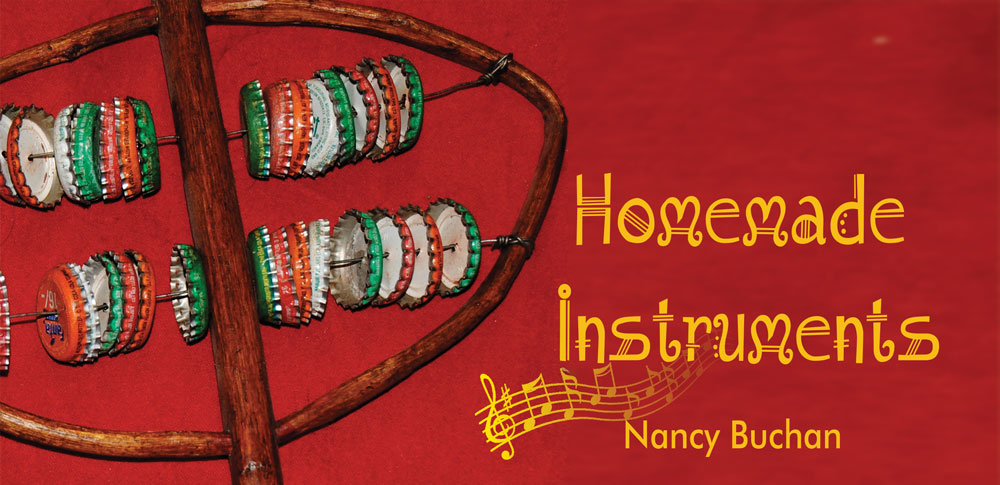Homemade Instruments

We have all been deprived of being able to listen to live music this past year—and even worse, we haven’t been able to play with other musicians. Myself, and most of my musician friends, have been sitting at home on Friday nights instead of playing LIVE MUSIC for you folks to sing along to, or to dance to. The kids at the school in San Isidro where I teach have had to rely on cell phones to receive their virtual lessons, instead of being able to play in an orchestra or to play duets with their pals. It just sucks, and there is no polite way to say that. Of course, we all hope things get back to ‘normal’, but that word may have already become meaningless. I totally admire the teachers of the world who are trying to use whatever means they can to help aspiring musicians continue to play and to get more proficient and to enjoy themselves.
Learning to use and value the natural resources around us is a practical and respectful way to approach living here. As musicians, we have to find ways for folks who would like to participate in music sessions to be able to do so. Ways to expose kids (and adults) to rhythms and sounds without having to be in a scholastic or technical or purely electronic setting. I firmly believe we have to get behind the spirit of this concept. Just look around you, listen to the natural sounds here, take guidance from the ancestors—and start making your own instruments! GET CREATIVE!
Our shopping options are few anyway, and most music stores here are obsessed with all things glitzy and shiny and new—items which are routinely sabotaged by the climate or bugs or the salt air. After all, music started with ingenious usage of the plants and shells and animals available, and there are plenty of historical and current examples to be inspired by. It’s fine to listen to recordings and watch YouTube and such, but we need to take the proverbial bull by its horns. Let’s make and play some homemade music, starting with Instrumentos Caseros.

Percussion instruments are a good place to start, as they serve as a means to communicate non-verbally with the guy in the next valley as well as being the guiding beat for all kinds of musical fun. And people do love to bang on things! Hollow out a gourd or grab a tin can or plastic pop bottle and seal in dried seeds or popcorn or small rocks, then shake it. Or string dried seeds together and wind them around the outside of a hollow gourd and you’ve got a different version of maracas. Claves is the name for two rounded hardwood sticks that make a great sound when whacked together. (Clave is also the name for a 5 beat, measure and a half long rhythmic pattern that’s basically the foundation for many of the rhythm styles found in Latin music.) Collect your old obsolete metal keys (I have drawers full of them) string them together with fishing line, hang them in rows from a stick and you have great sounding chimes. Certain palm fronds—the long, narrow, spikey ones—make great rattles. As do animal or bird claws strung together or those long, boomerang looking seed pods. You don’t need store bought instruments or videos—just go collect some stuff from the nearby woods or jungle. If a 3rd grade teacher can build a castle out of popsicle sticks then surely, we can come up with a percussion section made from seeds and stems. GET CREATIVE!

Stretch animal hide or thin rubber over a round frame, add some bottle caps and you’ve got a tambourine. Make a guiro out of a gourd (usually Calabaza) by carving rows of ridges on one side, (kinda like frets), carve out a sound hole on the other side, then scrape a stick over the ridges. The kind of elongated beat this small but important instrument supplies is a main driving force for many Latin rhythms. Cut some different sized coconuts in half, clean them up, mount them on posts waist high and play them like a drum kit. Fill a dried cactus with small stones and nails and you’ve got a rainstick. The cajon (box) is a very popular and versatile drum used throughout Central and South America. Build a box out of wood and cut a resonator hole in the front, sit on it and use your hands to beat out rhythms in different places for different tones. Some cajons have small nails put in slightly larger holes or metal springs or coils attached inside to achieve a snare drum sound. Go Australian and make a didgeridoo out of a bamboo tree. Turn a conch shell into a horn. GET CREATIVE!

The variety and quantity of the styles of music available to listen to in Costa Rica is overwhelming and inspiring, and since we can’t have people playing together in our schools or bars or beaches because of this darn pandemic, then we just have to GET CREATIVE! For starters, “Latin Music” is a term that just doesn’t explain enough. So many styles can fall under that heading—Salsa, Meringue, Trova, Son, Jazz, Cumbia, Rumba, Folkloric, Ranchero, Calypso, Soca, African, Caribbean, Brazilian, Mambo, Samba, Mariachi, Tango…… And that is barely scratching the surface. In general, Latin Music is part-oriented. Each instrument or voice has a fairly specific role to play in the interlocking web of rhythms, melodies and harmonies. Everybody has their job to do to contribute to the overall sound. I think if you really want to understand a style of music with any kind of authenticity, you need to know something about how it developed and its roots. The instruments, language, and customs of the regions where it came from, the politics and philosophy, the controversies, the triumphs, the sorrows, and the joys of the people who gave birth to it. Costa Rica’s modern-day music was originally influenced by many different cultures, and the instruments that evolved here were also diverse and somewhat organic. Trying to define “Latin” music or even “Salsa” is like trying to pinpoint how “Jazz” or “Rock” got started. These styles contain elements of different geographies and cultures. When African rhythms and instruments met the Spaniards, both styles were changed forever. For the oppressed, the result was often a way to communicate dissent or to affect change politically—another example of how to GET CREATIVE.
So, go join a bunch of folks playing ukuleles on the beach—make yourself some bongo drums out of coconuts—sing along to the radio whether you know the words or not. I have mostly been writing about rhythms and percussion instruments, but of course we can invent or modify many instruments and they can become something new. Get a cigar box and make a guitar—turn a hubcap into a banjo—take a tip from the teachers and make a harmonica from popsicle sticks. GET CREATIVE!
Creativity is intelligence having fun. Albert Einstein
You can’t use up creativity. The more you use the more you have. Maya Angelou
Songs are pretty easy. They are small, they are modular, they are about as big as a bagel. Tom Waits


wow great blast from the past! I often think affectionately of the Snake – had some big fun there. Don (guitar player/singer) lives in Hawaii and is now a fish scientist, bass player lives in Boulder, I live in Costa Rica, Jerr the pianist has passed and the percussionist lives in Vale I think. Nice to hear from you and to realize people actually read these thinga!!!! Michael the drummer and singer lives in Austin and I am contact with him the most. Best wishes to you!!!
Hi Nancy,
This is Normy the musical singin busboy from the Snake River Saloon. Your blog is wonderful, thank you! Remembering the days of the New Moon…I can hear one of the songs from that far away time and place…”Live and Love in the City” and I remember Suzy Paris from Boulder, too…and Carole from the Snake is on my facebook…ah life…I live in Ocean Park WA now…I believe Jimmy Shields is still running the Snake, and Carole is living in Littleton now. Hope all is good where you are!